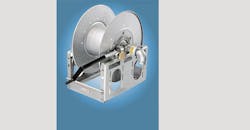What to consider when selecting swivel joints for hose reels, loading arms, and other equipment
From petroleum transports to storage terminals to refineries, swivel joints are essential components for all kinds of machinery and applications. The components provide the smooth connection between stationary pipes or hoses and rotating machinery parts.
Design, plant and maintenance engineers use swivel joints in flexible piping systems, loading arms, hose reels, sewer rodding and wastewater treatment equipment, and various types of process machinery. They also use swivel joints in machine tool coolant transfer, drum-filling applications, and in a variety of in-plant fluid and dry bulk transfer applications.
The most advanced machinery can break down if the machine elements aren’t able to move. Swivel joints are necessary investments that pay off in a big way. They extend machinery lifetime and reduce maintenance and downtime.
It’s extremely important to follow the manufacturer’s specifications when selecting swivel joints. If the requirements aren’t met, it’s likely that leakage will occur and the machinery will fail.
It is critical to understand the design parameters of a given application. Things such as pressure, temperature, and supported weight all play an essential role in properly selecting a swivel. Another key factor that must be taken into consideration is the corrosiveness of the fluid itself.
The application environment is critical to selecting the right swivel joint. By carefully considering the fluid’s chemical composition, its temperature and the external environment, you’ll be able to narrow in on the perfect swivel joint.
The breadth of swivel joints is endless when you consider the potential combinations of sizes, seals, and connections, not to mention metals. These metals include carbon steel, stainless steel, brass, aluminum, bronze and ductile iron.
Versatility is the key to any effective swivel joint as specification can vary drastically depending on the job and functionality required.
Swivel joints are available in one, two and three planes of rotation for virtually unlimited flexibility. Standard combinations of metals and seal materials cover pressures, temperatures, corrosion resistance and load bearing capacities, well within the limits of most application requirements. The list of end connections is also extensive. Threaded (NPT), flanged (150/300 ANSI) and butt-weld ends are some of the most common.
Custom swivel joints can be designed and manufactured for any possible application. Engineers can help you determine the appropriate design for your special application by providing experienced consultation, backed up by the right swivel design, tailored specifically to meet your application needs. Specialty swivels are available in a wide range of materials and sizes.
A few of the most typical applications include:
- Loading arms
- Hose reels
- Steel mills
- Marine/dock hoses
- Fire fighting equipment
- Machine tools
- Filtration equipment
- Waste water treatment
- Aviation ground support equipment
- Tank trucks
- Drum fillers
Here’s a quick look at some of the most used swivel joints and how they impact the effective flow of fluids across an array of industries.
Loading arm systems allow the transfer of fluids or liquefied gas into a tank truck or rail car through a flexible piping system. Some applications require a loading arm to load through a top connection, while other connection points are at the bottom.
The functionality of loading arm swivel joints has evolved over the years to meet the demands of fluid handling solutions. Whether the application involves tank trucks, railcars, drums or totes, and the moving of petroleum products, liquefied gases, asphalt, solvents or hazardous/corrosive chemicals, swivels play an integral part in the process.
Swivel joints are an integral part of many hose reel applications and there is a large variety of these parts designed specifically for hose reels. In addition, there’s the ability to customize a hose reel swivel to fit your specific application.
Dual Split Flange swivel joints are specifically designed to transfer acids, solvents, petrochemicals and other toxic fluids. This type of swivel joint feature heavy-duty construction and unique design components that help make it the best available swivel technology in the industry.
No matter what type of industrial fluid application you’re operating in, swivels are helping get the job done. They are flexible, efficient, cost-effective and durable. For more information on swivel joint features and custom design capabilities, please visit OPW Engineered Systems.
Dave Morrow is Director of Product Management for OPW Engineered Systems, part of Dover Corporation’s OPW division. He can be reached at (800) 547-9393 or [email protected].
